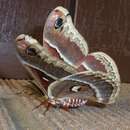In Alberta, this species is similar only to
H. cecropia, from which it differs in being primarily a maroon colour, rather than black.
H. cecropia also has a bright red band along the outer margin of the transverse white band, which is absent in
H. gloveri.
cc-by-nc
copyright
University of Alberta Museums

